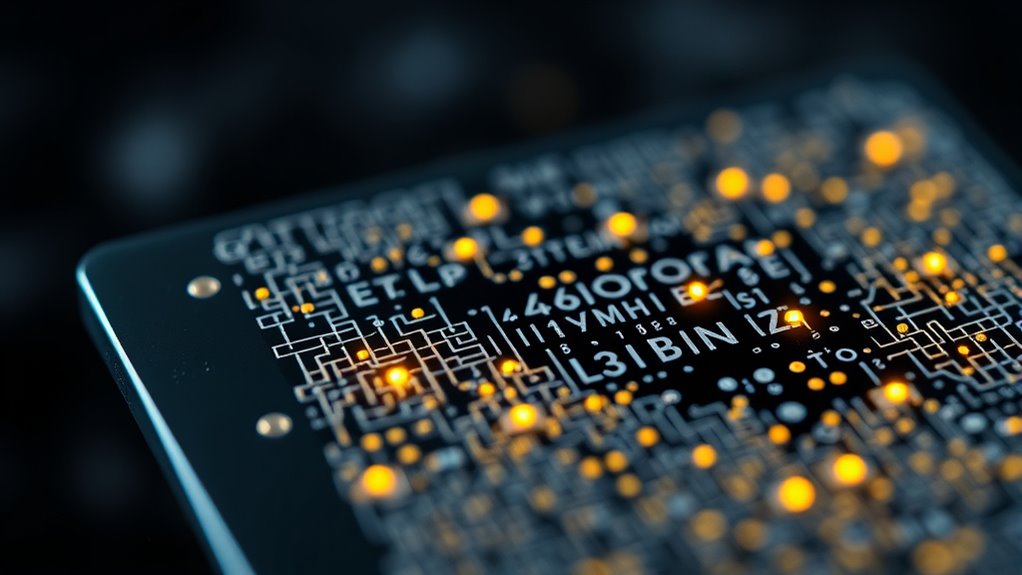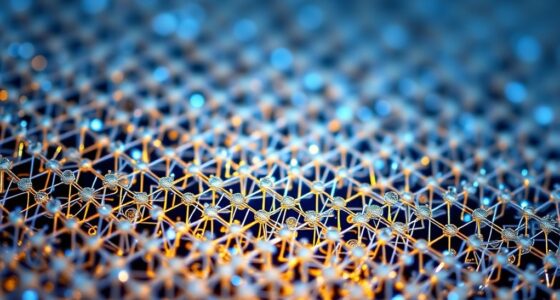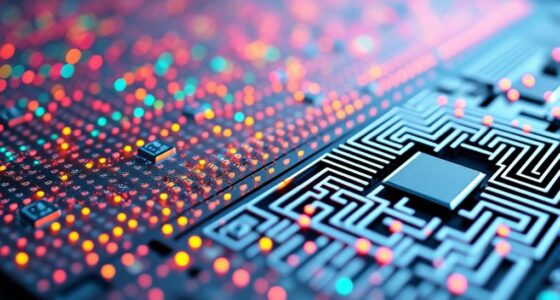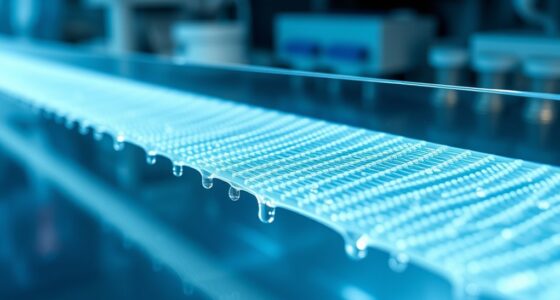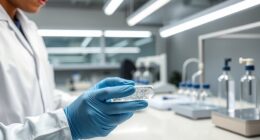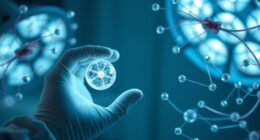Nanobiosensors use nanoscale devices to detect biomolecules with high sensitivity and specificity. They transform biological interactions into electrical or optical signals, allowing quick identification of molecules like DNA, proteins, or enzymes. Techniques involve nanowires, nanoparticles, and advanced fabrication methods to enhance performance. External interference can affect accuracy, but ongoing innovations aim to improve reliability and applications in health, environment, and beyond. Keep exploring to discover how these tiny devices are revolutionizing detection technologies.
Key Takeaways
- Nanobiosensors detect biomolecules by converting biological interactions into electrical or optical signals with high sensitivity.
- They use nanoscale materials like nanoparticles, nanowires, and quantum dots to enhance detection capabilities.
- Recognition elements such as antibodies and aptamers provide high specificity for target biomolecules.
- Fabrication techniques like electron beam lithography enable precise nanoscale device construction for reliable sensing.
- These devices are applied in healthcare, environmental monitoring, and food safety due to their rapid, real-time detection abilities.
Understanding the Fundamentals of Nanobiosensors
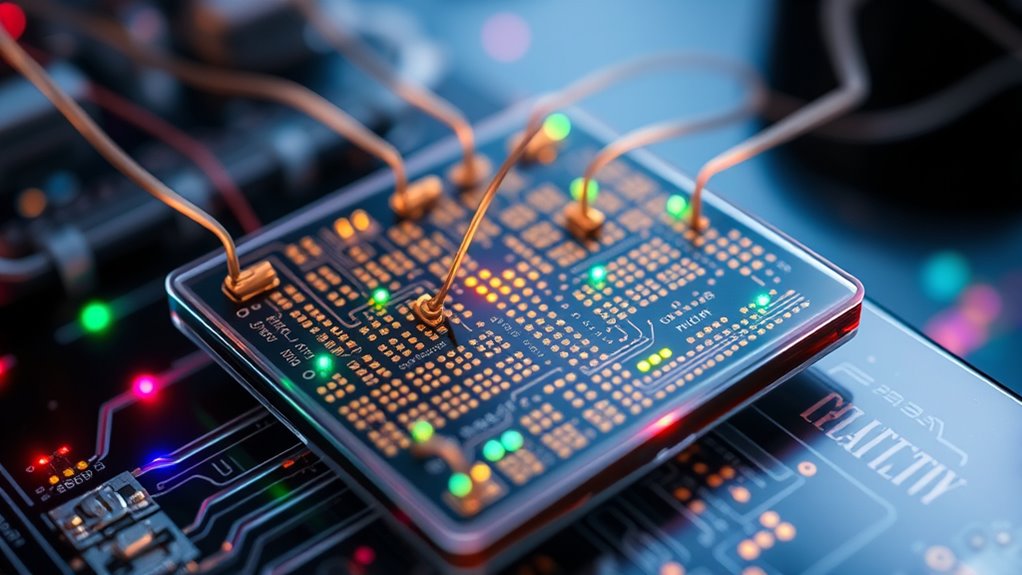
Nanobiosensors are innovative devices that detect biological molecules with remarkable sensitivity and specificity. When you use a nanobiosensor, you’re relying on nanoscale materials and structures that can identify specific biomolecules, even at very low concentrations. These sensors operate by translating biological interactions into measurable signals, often electrical or optical. The core principle involves recognizing a target molecule, such as an enzyme, protein, or DNA strand, and converting that recognition into a detectable response. This high level of precision stems from the nanoscale features that increase surface area and enhance interaction efficiency. Additionally, vetted product reviews can inform the selection of high-quality nanobiosensor components and accessories. Understanding these fundamental mechanisms helps you appreciate how nanobiosensors can be applied across medical diagnostics, environmental monitoring, and food safety, providing rapid and accurate results in various fields.
Types of Nanoscale Devices Used in Biosensing
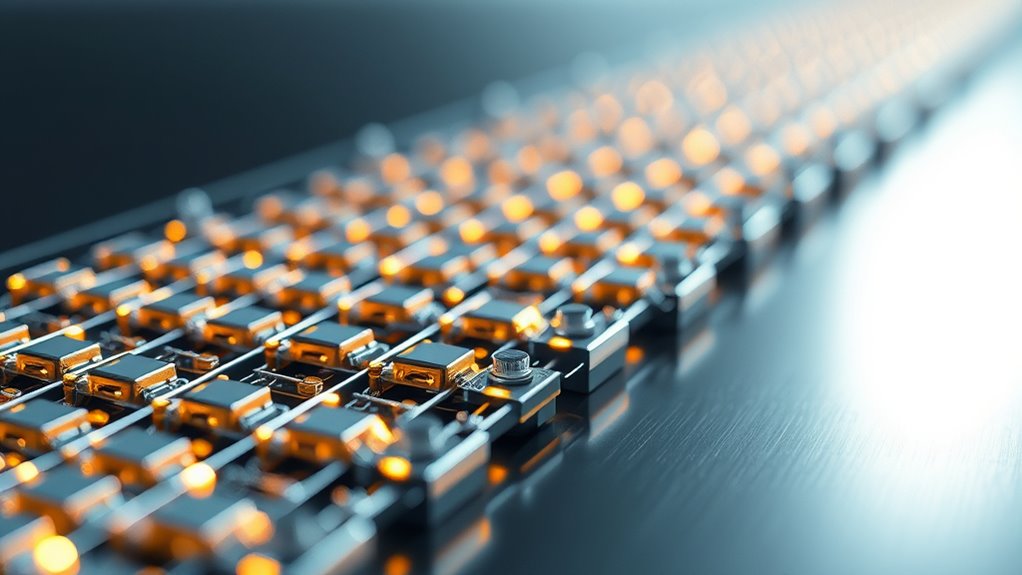
To effectively detect biological molecules at the nanoscale, various types of nanoscale devices are employed in biosensing applications. You might use nanoparticles, such as gold or quantum dots, which provide high surface area and unique optical properties for sensitive detection. Nanoscale transistors, like nanowire or nanotube field-effect transistors, enable you to measure electrical changes when biomolecules bind to their surfaces. Nanoscale mechanical devices, including cantilevers, detect biomolecular interactions through changes in resonance frequency or deflection. Additionally, nanoscale optical devices like plasmonic sensors utilize surface plasmon resonance to identify target molecules. Each device type offers distinct advantages in sensitivity, specificity, and response time, allowing you to tailor biosensors for diverse applications in medical diagnostics, environmental monitoring, and food safety. Understanding how Tuning techniques optimize sensor performance can further enhance detection capabilities.
How Nanobiosensors Detect Biomolecules
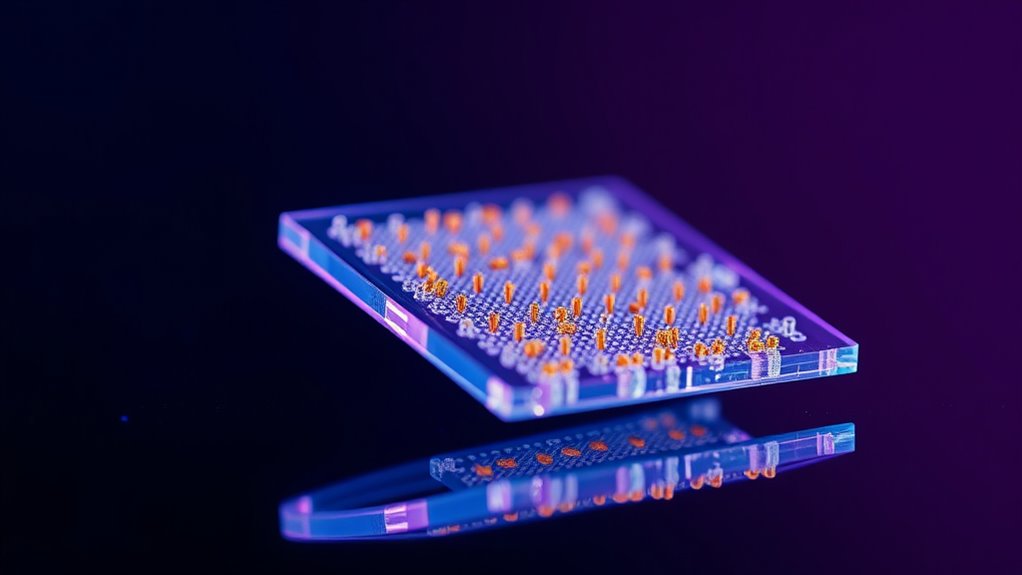
Nanobiosensors detect biomolecules by converting their binding events into measurable signals. When a target molecule binds to a specific recognition element on the sensor, it triggers a physical or chemical change. This change can produce an electrical signal, such as a change in current or voltage, which the sensor then amplifies and interprets. Alternatively, some nanobiosensors generate optical signals, like fluorescence or absorbance, upon binding. The sensitivity of these devices allows detection of even tiny amounts of biomolecules. The detection process is rapid and highly specific, thanks to the carefully designed recognition elements, such as antibodies or aptamers. This direct conversion of molecular interactions into electronic or optical signals enables precise, real-time analysis essential for diagnostics and research. Incorporating pressure relief features can further enhance the stability and performance of nanobiosensors during operation.
Fabrication Techniques for Nanoscale Biosensors
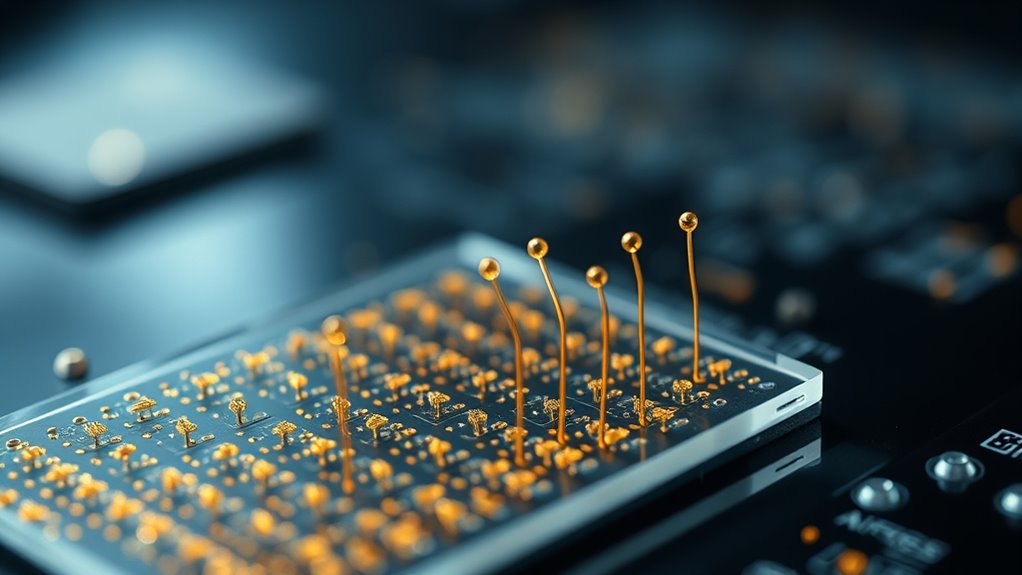
Creating highly sensitive nanoscale biosensors requires precise fabrication techniques that allow for accurate control at the atomic and molecular levels. Techniques like electron beam lithography, atomic layer deposition, and focused ion beam milling enable you to craft nanoscale features with exceptional precision. These methods allow for the integration of functional nanostructures essential for biomolecule detection. Additionally, understanding the impact of contrast ratio can help optimize the optical components used in biosensor imaging systems.
Enhancing Sensitivity and Specificity in Detection
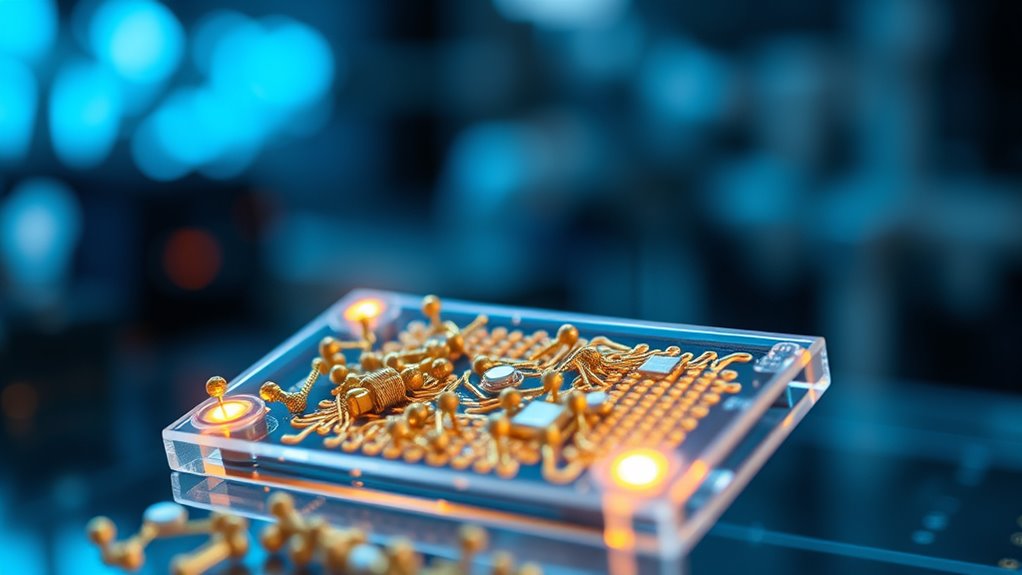
Enhancing sensitivity and specificity in detection is essential for the effective performance of nanoscale biosensors. To achieve this, you can optimize surface chemistry to improve target molecule binding while reducing background noise. Incorporating nanostructures like quantum dots or nanowires amplifies signals, making even low concentrations detectable. Using highly selective recognition elements, such as aptamers or antibodies, guarantees that the sensor distinguishes target biomolecules from similar ones. Additionally, you can implement signal amplification techniques like enzymatic reactions or electrochemical methods to boost detection signals. Proper calibration and noise reduction strategies are also critical. AI security technologies can be employed to monitor and detect anomalies in biosensor data streams, ensuring data integrity and security. By focusing on these aspects, you increase the biosensor’s ability to accurately identify and quantify specific biomolecules, leading to more reliable and sensitive detection outcomes.
Applications in Medical Diagnostics
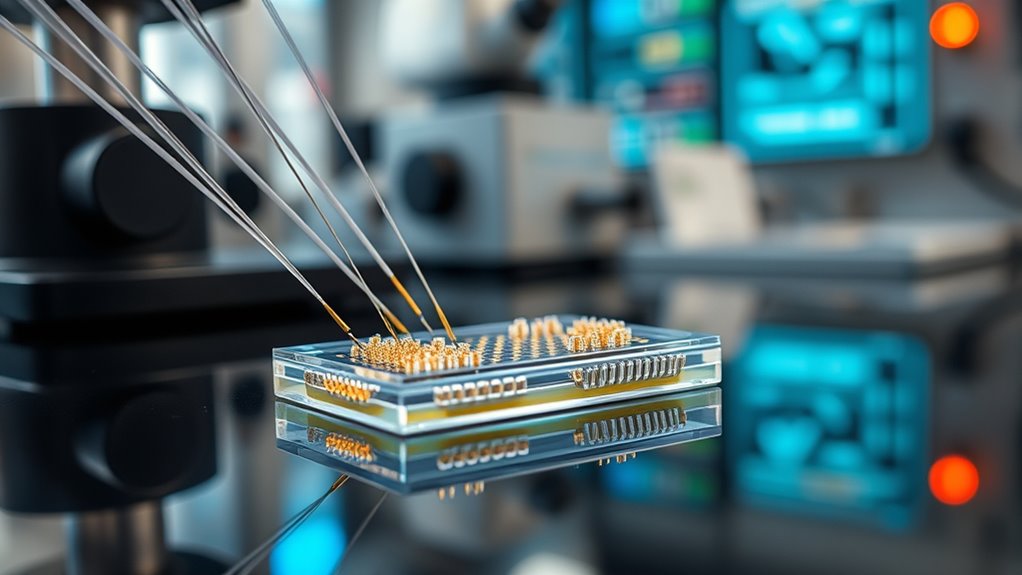
Nanobiosensors are transforming medical diagnostics by enabling early detection of diseases, often before symptoms appear. They also allow for real-time monitoring of treatments, helping you adjust therapies quickly. This technology offers a personalized approach that can improve outcomes and reduce unnecessary interventions. Safe food choices are essential to prevent adverse reactions during diagnostic procedures involving biomolecules.
Early Disease Detection
Have you ever wondered how early detection of diseases can transform healthcare? Nanobiosensors make this possible by identifying biomarkers at their earliest stages, often before symptoms appear. These tiny devices can detect trace amounts of molecules associated with conditions like cancer, Alzheimer’s, or infectious diseases, providing rapid and accurate results. Their high sensitivity and specificity allow for continuous monitoring, giving you real-time insights into your health. Because nanobiosensors are portable and require only small samples, they enable screenings outside traditional labs, even at home or in remote areas. This early diagnosis can lead to more effective treatments, better outcomes, and reduced healthcare costs. Additionally, sensitivity and specificity are key factors that determine the reliability of these sensors in detecting specific biomolecules. By catching diseases early, you’re empowered to take proactive steps toward maintaining your health and preventing serious complications.
Personalized Treatment Monitoring
Ever wondered how personalized treatment plans are becoming more accurate and responsive? Nanobiosensors enable real-time monitoring of biomarkers, allowing you to track disease progression and adjust therapies instantly. These tiny devices detect specific molecules in blood, saliva, or other fluids with high sensitivity. They provide immediate feedback, helping you and your healthcare provider make informed decisions. The table below highlights key benefits and applications:
| Benefits | Applications |
|---|---|
| Continuous, real-time data | Monitoring chronic conditions like diabetes |
| Early detection of treatment failure | Adjusting medication dosages rapidly |
| Minimally invasive | Personalized therapy optimization |
Furthermore, advancements in biosensor technology are expanding the possibilities for more precise and accessible diagnostics.
Environmental Monitoring With Nanobiosensors
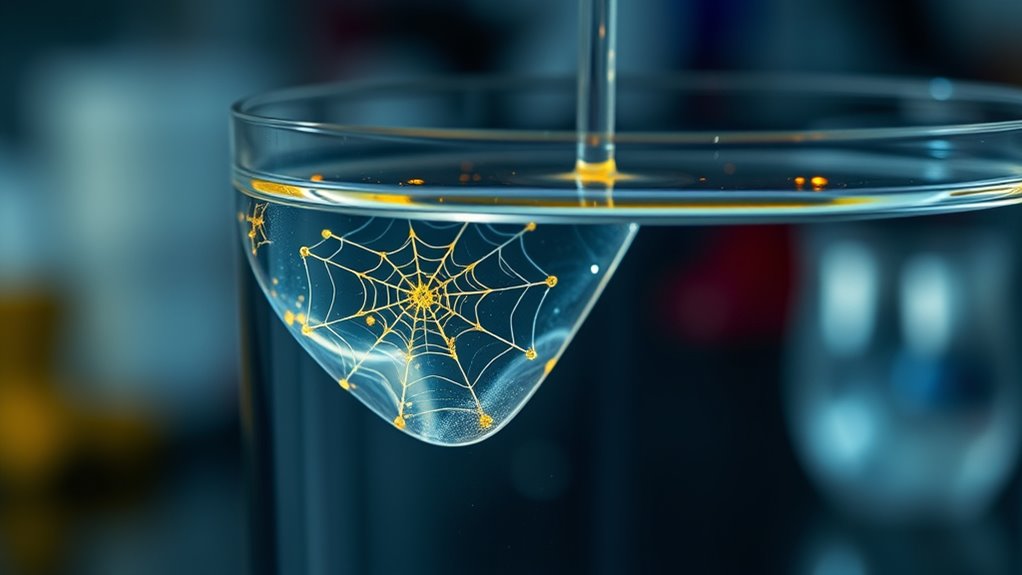
Because of their high sensitivity and rapid response times, nanobiosensors are increasingly essential tools for environmental monitoring. They can detect pollutants, toxins, and pathogens at extremely low concentrations, providing real-time data that helps you respond quickly to environmental threats. These devices are small, portable, and capable of on-site analysis, eliminating the need for complex laboratory setups. By integrating nanomaterials like nanoparticles and nanotubes, nanobiosensors enhance detection accuracy and stability. The use of high-quality materials in their construction improves durability and performance in diverse environmental conditions. You can use them to monitor water quality, air pollution, and soil contamination effectively. Their ability to identify specific biomolecules or chemicals ensures precise tracking of environmental changes. As a result, nanobiosensors empower you to make informed decisions, promote sustainability, and protect ecosystems with minimal delay.
Challenges and Limitations in Nanoscale Detection
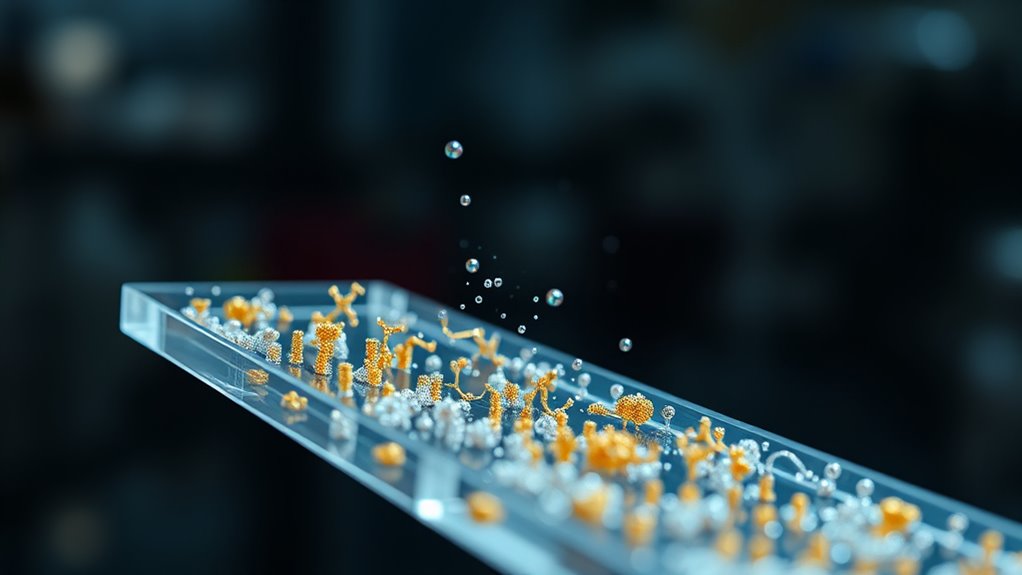
You might face signal interference that can distort sensor readings at the nanoscale, making accurate detection difficult. Scaling up production also presents challenges, as maintaining precision and consistency becomes harder with smaller components. Addressing these issues is essential to guarantee reliable and widespread use of nanobiosensors. Additionally, understanding the underlying techniques of somatic therapy can help improve the effectiveness of treatments aimed at emotional healing.
Signal Interference Issues
Signal interference poses a significant challenge in nanoscale detection with nanobiosensors, as the small size and high sensitivity of these devices make them particularly vulnerable to external disturbances. External electromagnetic fields, temperature fluctuations, and chemical contaminants can all produce signals that mimic or obscure the target biomolecule’s response. This interference can lead to false positives or negatives, compromising detection accuracy. You need to carefully control the environment around your sensor, minimizing sources of noise and shielding it from electromagnetic interference. Calibration becomes essential to distinguish genuine signals from background noise. Additionally, the complexity of biological samples introduces unpredictable interference, requiring advanced signal processing techniques. Overcoming these issues is critical for reliable, real-world applications of nanobiosensors.
Scaling and Manufacturing Challenges
Scaling nanobiosensors from laboratory prototypes to mass production presents significant hurdles. First, manufacturing at the nanoscale requires precise, reproducible techniques that are difficult to scale efficiently. Second, maintaining quality control becomes complex because small variations can drastically affect sensor performance. Third, high costs are involved in developing specialized equipment and processes for large-scale fabrication. Finally, integrating nanobiosensors into existing production lines demands compatibility with current technologies, which isn’t always straightforward. Overcoming these challenges involves developing standardized manufacturing protocols, improving automation, and reducing costs. Without addressing these issues, widespread deployment remains limited, hindering the full potential of nanobiosensors in real-world applications.
Future Trends and Innovations in Nanobiosensing
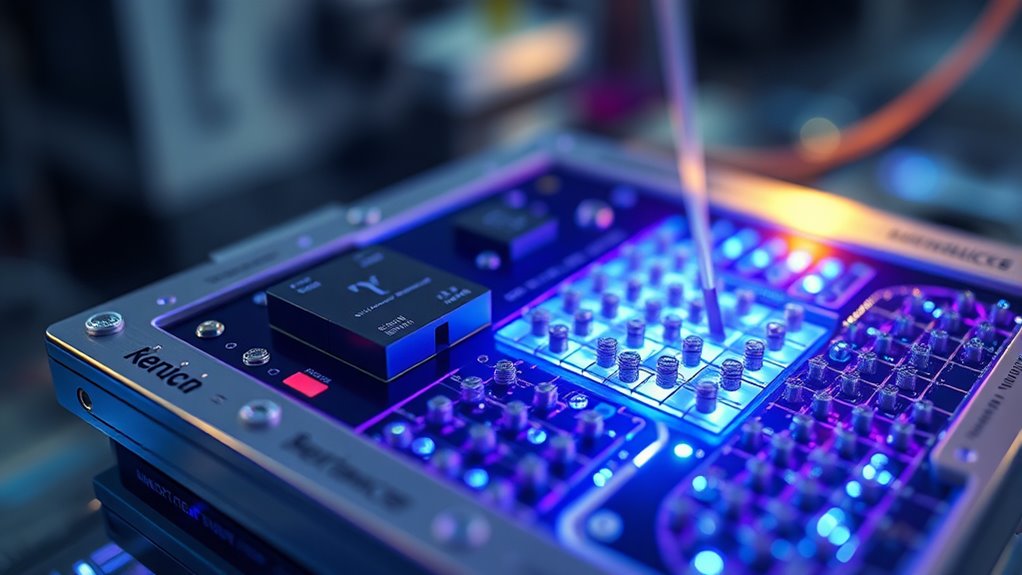
As nanobiosensing technology continues to advance, researchers are exploring innovative ways to enhance sensitivity, specificity, and real-time detection capabilities. You can expect the development of multifunctional sensors that combine multiple detection methods, improving accuracy and reliability. Advances in nanomaterials, like graphene and nanowires, will enable even smaller, more efficient devices. Integration of artificial intelligence and machine learning will allow these sensors to analyze data quickly and accurately, making real-time diagnostics more accessible. Wearable and portable nanobiosensors are also on the horizon, offering continuous health monitoring outside clinical settings. Additionally, innovations in surface chemistry will improve biocompatibility and reduce biofouling, increasing sensor lifespan. These trends will reshape how you detect and monitor biomolecules, making nanobiosensing faster, more precise, and more adaptable for various applications.
Impact on Healthcare and Beyond
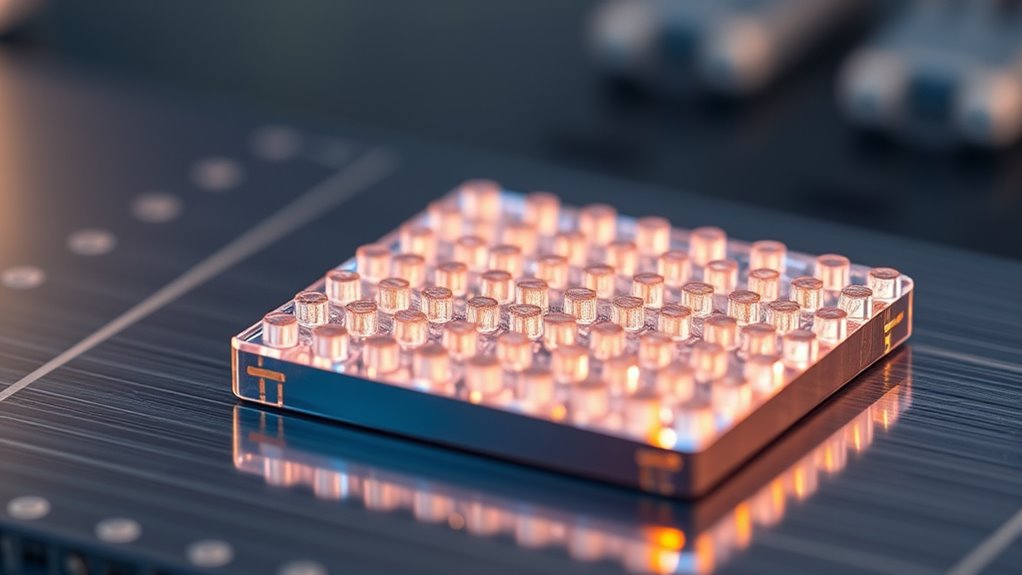
Nanobiosensors are revolutionizing healthcare by enabling rapid, accurate, and minimally invasive diagnostics. You can now detect diseases early, improving treatment outcomes and saving lives. Beyond healthcare, these devices impact areas like environmental monitoring and food safety. Specifically, they:
- Provide real-time data, allowing swift responses to health crises or environmental hazards.
- Reduce costs by minimizing the need for complex lab tests and invasive procedures.
- Enable personalized medicine, tailoring treatments based on individual biomolecular profiles.
- Promote global health equity by making diagnostics accessible in remote or underserved regions.
This technology’s versatility extends its influence far beyond medicine, shaping a safer, healthier future across multiple sectors.
Frequently Asked Questions
What Are the Environmental Impacts of Manufacturing Nanobiosensors?
You should consider that manufacturing nanobiosensors can have environmental impacts like toxic waste generation, energy consumption, and resource depletion. Manufacturing processes may release hazardous chemicals into water and air, potentially harming ecosystems and human health. Additionally, sourcing raw materials for nanoscale components can contribute to environmental degradation. To minimize these impacts, it’s crucial to adopt sustainable practices, optimize resource use, and guarantee proper waste management during production.
How Do Nanobiosensors Compare to Traditional Detection Methods?
You’ll find nanobiosensors more sensitive, faster, and capable of detecting lower concentrations of biomolecules than traditional methods. They use nanoscale materials, enabling real-time analysis and miniaturization for portable devices. While conventional techniques like ELISA or PCR are reliable, nanobiosensors often require less sample, reduce analysis time, and can be integrated into wearable or point-of-care systems, making them a versatile and efficient alternative for biomolecule detection.
Are Nanobiosensors Reusable or Single-Use Devices?
Like a trusty pocket calculator, nanobiosensors can be either reusable or single-use, depending on their design. Many are built for multiple uses, allowing you to clean and recalibrate them for ongoing detection. However, some are disposable, especially when dealing with highly sensitive or hazardous samples, ensuring accuracy and safety. Your choice depends on the specific application, cost considerations, and the sensor’s durability.
What Regulations Govern the Safety of Nanobiosensor Deployment?
You should be aware that regulations governing nanobiosensor safety vary by country and application. Agencies like the FDA in the US or EMA in Europe set guidelines to ensure safety and efficacy before deployment. You need to comply with these regulations, which include rigorous testing, risk assessments, and quality controls. It is crucial to stay informed about evolving standards to guarantee your nanobiosensors meet all legal and safety requirements for responsible use.
How Cost-Effective Are Nanobiosensors for Large-Scale Use?
You’ll find that nanobiosensors can be quite cost-effective for large-scale use, especially as manufacturing processes improve and economies of scale kick in. While initial setup costs might be high, their ability to quickly and accurately detect biomolecules can reduce overall healthcare expenses. Additionally, their small size and low reagent consumption help lower operational costs, making them a promising option for widespread application in diagnostics and environmental monitoring.
Conclusion
Nanobiosensors revolutionize biomolecule detection, offering rapid, precise, and real-time analysis. With over 50% of medical diagnostics expected to incorporate nanobiosensing by 2030, their potential is enormous. You can harness these tiny devices for healthcare, environmental monitoring, and beyond. As technology advances, expect even greater sensitivity and applications. Embrace the future of nanoscale detection—where small devices make a big impact on your world.
